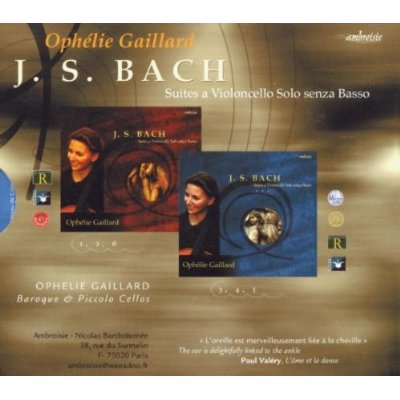
Ophélie Gaillard, Bach Cello Suites. ambroisie AMB 9905/6 Released 2001.
Recorded 2001 Chapelle du Château de Corroy. Producer. N, Bartholomée
Instruments used: early 18thcentury anonymous maker.
Violoncelle piccolo de Lannoy. (6thSuite)
The Cellist.
Gaillard has recorded the Bach Cello Suites twice. This is the earlier of the two. My friend Mark has reviewed the later recording elsewhere on this web site.
Gaillard has a keen interest in Baroque music and videos of a performance from about 2008 suggest she uses a baroque bow. Unfortunately, there are no details about the set up of her cello in the booklet that accompanies this release. Otherwise it is very well packaged and informative including a personal reminisce of her childhood inspiration, Paul Tortelier.
The Recording.
In terms of the overall sound and presentation, this recording has to be one of the most sumptuous and impressive I have heard. I suspect gut strings will have been used but there is very little scratchiness in the upper registers. At the other end of the scale, the bass whilst being full and mellow is not overpowering. There is no booming and the fundamental frequency is clearly heard. There is smoothness right across the frequency range which I suspect is credit not only to the soloist but to the producer.
Right from the off, this is a rendition that gripped me. It excited, and sustained interest until the end of over 2 hours listening. There are moments when Gaillard’s performance had me sitting on the edge of my seat and others where I felt a sense of awe.
Highlights.
If I were to select high points they would include all of the Preludes, particularly the final sixth. Here I would also comment that the piccolo cello sounded remarkably full bodied even in the lower registers. The upper registers had an almost organ like sound which was very attractive.
Gaillard plays with obvious enthusiasm and verve. This, on top of her foremost technical ability gives a sense she can do no wrong.
This is where youth has played a part I suspect, as she will have been about 27 years old. There is very strong attack in the “big moments”. Lightness and nimbleness in the fast movements and quiet serenity in the slower Sarabandes. There is plenty of light and shade in all of the pieces. Well considered variation in repeats, mainly with changes of ornamentation amplify this variation.
Conclusion.
Tortelier sadly died about 10 years before this release, but had he been alive I’m sure he would have been bowled over by Gaillard’s performance, I know I certainly was.
Charles.
Ophélie Gaillard, ambroisie AMB 9905/6 Released 2001.
Introduction.
I have already reviewed the later set of the Suites by Gaillard. Charles has given an informative review of this earlier one which he kindly lent to me recently for a listen. Therefore, my intention is not to provide an extended review. That has already been admirably addressed. However, I will make some general comparisons with the later set, with which I was quite enamoured by overall.
The Recording.
From the attack of the 1st Suite Prelude in this earlier version, I felt that this was going to be a fairly fearless young person’s reading. In comparison, the later set felt more relaxed to me. It also seemed to have a greater sense of fantasy and space to breathe. The first version by contrast had a fuller sound, very rich, and also weightier. Occasionally I felt the first set’s fearlessness did end up tending to the reckless.
By way of example the 6th Suite Prelude, a highlight for Charles, was for me too rushed at the start, with some notes becoming blurred. On this point, and for the reader’s benefit, it might be worth pointing out that Charles and I identified quite early on that we do to a degree look for different things in the Suites. Charles favours the exciting movements and I the more melancholy ones. This could perhaps help to explain why we may take slightly different views of the same movement.
A bit of a niggle.
Two things are sadly consistent across the versions under consideration. In both we have some intrusive breathing and finger tapping being picked up, which is interesting as they were produced by different recording companies.
Conclusion.
One final comment on the comparison between the two versions. I had an impression that whilst the later one fitted neatly in the French heritage, this earlier one for me sounded more of the Germanic school of playing.
Mark.